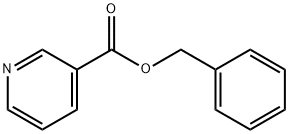Ethyl nicotinate , 99% , 614-18-6
Synonym(s):
Ethyl 3-pyridinecarboxylate;Ethyl nicotinate, 3-Pyridinecarboxylic acid ethyl ester, Nicotinic acid ethyl ester;Nicotinic acid ethyl ester
CAS NO.:614-18-6
Empirical Formula: C8H9NO2
Molecular Weight: 151.16
MDL number: MFCD00006389
EINECS: 210-370-7
| Pack Size | Price | Stock | Quantity |
| 25G | RMB28.80 | In Stock |
|
| 100G | RMB63.20 | In Stock |
|
| 500G | RMB279.20 | In Stock |
|
| 2.5kg | RMB1335.20 | In Stock |
|
| others | Enquire |
PRODUCT Properties
| Melting point: | 8-10 °C (lit.) |
| Boiling point: | 223-224 °C (lit.) |
| Density | 1.107 g/mL at 25 °C (lit.) |
| vapor pressure | 4.2-5.5Pa at 20-25℃ |
| refractive index | n |
| Flash point: | 93 °C |
| storage temp. | Store below +30°C. |
| solubility | 50g/l |
| pka | pK1:3.35(+1) (25°C) |
| form | liquid |
| Specific Gravity | 1.107 |
| color | light yellow |
| Water Solubility | miscible |
| BRN | 122937 |
| InChIKey | XBLVHTDFJBKJLG-UHFFFAOYSA-N |
| LogP | 1.32 |
| Surface tension | 72mN/m at 1g/L and 20℃ |
| CAS DataBase Reference | 614-18-6(CAS DataBase Reference) |
| NIST Chemistry Reference | 3-Pyridinecarboxylic acid, ethyl ester(614-18-6) |
| EPA Substance Registry System | Ethyl nicotinate (614-18-6) |
Description and Uses
Ethyl nicotinate is a chemical attractant used to prevent and control plant pests. Ethyl nicotinate was found to be a potent attractant forThrips obscuratus in peaches and apricots. It is more attractive than ripe fruit and catches peak at harvest. Long season trapping demonstrated the efficiency of chemical traps compared to unbaited traps. The attractiveness of the chemical was maintained for at least 2 weeks when 50 μl of the chemical was placed in an open 2 ml vial cap. Various pyralids, geometrids (Lepidoptera), and chironomids (Diptera) were also attracted in low numbers to ethyl nicotinate[1].
Ethyl nicotinate is used for skin-conditioning cosmetics. It is principally used in medicine as a local vasodilator at a concentration of 1 to 2 % in creams, ointments and pomades. It is utilized for the treatment sprains, wrenches, muscular pains and tendonitis.
Safety
| Symbol(GHS) |   GHS05,GHS07 |
| Signal word | Danger |
| Hazard statements | H314-H335 |
| Precautionary statements | P261-P271-P280-P303+P361+P353-P304+P340+P310-P305+P351+P338 |
| Hazard Codes | Xi |
| Risk Statements | 37/38-41-36/38-36/37/38 |
| Safety Statements | 26-39-37/39-36 |
| WGK Germany | 3 |
| F | 8-9-23 |
| TSCA | Yes |
| HS Code | 29333999 |
| Toxicity | LD50 orally in Rabbit: > 2005 mg/kg |



